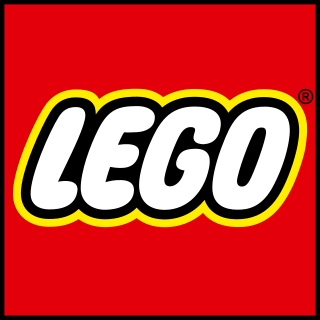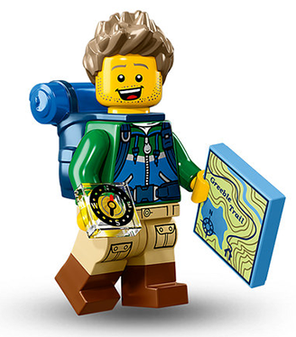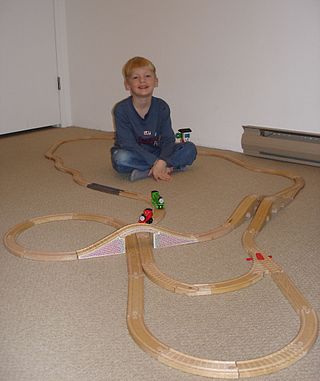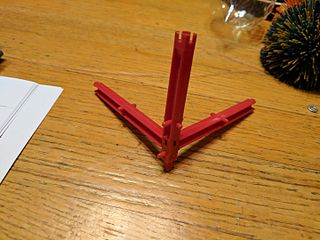Composition
At its core was a cube-shaped building block called a "Tog'l Block". Each side of the block had a hole or a pin that could be used to connect to the corresponding element (pins snapped into holes) on the side of another block. A chief advantage of Tog'l blocks over Lego (and similar) bricks is that a Lego brick can only attach to other bricks on two of its faces (top or bottom), while Tog'l blocks could attach to others on all six of its faces (each of its six faces could attach to another block). However, Tog'l blocks suffered in that they were less stable and durable than Lego blocks.
Another feature that gave the product its name was that one side had a hinge that allowed models built with Tog'l blocks to flex and move. Other building elements included wheels, axles, pinion gears, tubes, girders, air bellows, windows, doors, blue pins, green "hemisphere" pins, red double pins, clown heads, pig heads, hands, feet, and many other variations with generic uses or specific purposes.

Lego is a line of plastic construction toys that are manufactured by The Lego Group, a privately held company based in Billund, Denmark. The company's flagship product, Lego, consists of variously colored interlocking plastic bricks accompanying an array of gears, figurines called minifigures, and various other parts. Lego pieces can be assembled and connected in many ways to construct objects, including vehicles, buildings, and working robots. Anything constructed can be taken apart again, and the pieces reused to make new things.

Lego Mindstorms is a hardware and software structure which develops programmable robots based on Lego building blocks. Each version includes computer Lego bricks, a set of modular sensors and motors, and Lego parts from the Technic line to create the mechanical systems. The system is controlled by the Lego bricks.
Lego Technic is a line of Lego interconnecting plastic rods and parts. The purpose of this series is to create more advanced models with more complex technical functions, compared to the simpler brick-building properties of normal Lego.

K'Nex is a construction toy system founded by Joel Glickman. It was first introduced in America in 1992. K'Nex is designed and produced by K'Nex Industries Inc. of Hatfield, Pennsylvania. K'Nex was purchased by Florida-based company Basic Fun! in 2018.

This article lists notable events and releases in the history of the Lego Group.
Tyco Toys was an American toy manufacturer. It was acquired by Mattel in 1997.
The history of Lego began in 1932, when Ole Kirk Christiansen founded the company in a Danish carpentry workshop, and continues into the 21st century as a popular and very profitable line of construction toys and related products and services, with a significant impact on various areas of popular culture. Despite its expansion, the company remains privately held.

A construction set is a set of standardized pieces that allow for the construction of a variety of different models. The pieces avoid the lead-time of manufacturing custom pieces, and of requiring special training or design time to construct complex systems. This makes them suitable for temporary structures, or for use as children's toys. One very popular brand is Lego.

Lego A/S is a Danish toy production company based in Billund, Denmark. It manufactures Lego-brand toys, consisting mostly of interlocking plastic bricks. The Lego Group has also built several amusement parks around the world, each known as Legoland, and operates numerous retail stores.

A Lego minifigure, commonly referred to as a minifig, is a small plastic articulated figurine produced by Danish toy manufacturer The Lego Group. They were first produced in 1978 and have been a success, with over 4 billion produced worldwide as of 2020. Minifigures are usually found within Lego sets, although they are also sold separately as collectables in blind bags, or custom-built in Lego stores. While some are named as specific characters, either licensed from film, television, and game franchises, or of Lego's own creation, many are unnamed and are designed simply to fit within a certain theme. Minifigures are collected by both children and adults. They are highly customizable, and parts from different figures can be mixed and matched, resulting in many combinations.

Lego Trains is a product range and theme of the construction toy Lego, which incorporates buildable train sets. The Lego Trains theme became a sub-theme of Lego City in 2006. Products in the range have included locomotives, tracks, rolling stock, stations, signal boxes, and other track-side buildings and accessories. The theme is popular among adult fans, as well as children, and has spawned international associations and conventions. The train system is sometimes referred to as 'L-gauge' among Lego fans, in reference to traditional model railway scales. Lego trains use a nominal gauge of 37.5 mm, based on 5-stud track centerlines gauge, corresponding with a circa 1:38 scale.

Lego Space is a Lego theme that features astronauts, spaceships, and extraterrestrial life. Originally introduced in 1978, it is one of the oldest and most expansive themes in Lego history and contains over 200 individual sets. It was marketed under the Legoland banner until this became Lego System in 1992.
This is a list of toys created by the popular children's television network Nickelodeon.

Merchandise for the Thomas & Friends franchise has been produced to capitalize on the success of the television series Thomas & Friends. Whilst merchandise was produced alongside due to the popularity of the first of The Railway Series by the Rev. W. Awdry since 1945, and the original broadcast of the television series in 1984 in the United Kingdom, large numbers of manufacturers have sought to produce Thomas-branded items after the television series was broadcast in the United States and Japan.

Mega Brands Inc. is a Canadian children's toy company currently owned by Mattel. Mega Bloks, a line of construction set toys, is its most popular product. Its other brands include Mega Construx, Mega Puzzles, Board Dudes and Rose Art. The company distributes a wide range of construction toys, puzzles, and craft-based products.

Girder and Panel Building Sets were a series of plastic toy construction kits created by Kenner Toys in the mid-1950s. Since then, the building sets have gone in and out of production several times, under a succession of different owners of the designs.

Modular Buildings is a series of Lego building toy sets introduced in 2007, with new sets usually being released annually. Created in response to feedback and suggestions from the Adult Fans of Lego bricks (AFOL) and Teen Fans of Lego (TFOL) communities, the sets in this series are generally intended for more advanced builders. Most sets contain more than 2,000 total pieces and make use of unorthodox building techniques not usually used in previous official Lego sets. In contrast to most Lego sets aimed at children and adolescents, the suggested age of most sets in the Modular Buildings series is 16 years or older. The Modular Buildings sets have been received with positive reviews and are considered by Lego designers and fans as "toys for adults".
Lego Ninjago is a Lego theme that was created in 2011 and a flagship brand of The Lego Group. It is the first theme to be based on ninja since the discontinuation of the Lego Ninja theme in 2000. Whilst it retains some elements of the previous theme, it is based on a more detailed storyline set within a fantasy world, primarily underpinned by the computer-animated television series Ninjago.

A Lego clone is a line or brand of children's construction blocks which is mechanically compatible with Lego brand blocks, but is produced by another manufacturer. The blocks were originally patented by The Lego Group in 1961 as "toy building bricks", and the company has since remained dominant in this market. Some competitors have moved to take advantage of Lego brand recognition by advertising their own products as compatible with Lego, with statements such as "compatible with leading building bricks".

Building blocks are modular construction parts, usually made of plastic, which can be assembled in a form-fit manner. The basic components are usually cuboid-shaped, cylindrically studded at the top in a grid pattern, hollow-bodied at the bottom and smooth at the sides. The structured upper surface interacts by friction and positive locking with the correspondingly negative lower surface of other clamping components, so that complex designs can be assembled. The design allows the parts to be connected with compressive force and the blocks to be clamped with plastic pins.











